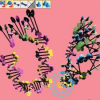Free Online Productivity Tools
i2Speak
i2Symbol
i2OCR
iTex2Img
iWeb2Print
iWeb2Shot
i2Type
iPdf2Split
iPdf2Merge
i2Bopomofo
i2Arabic
i2Style
i2Image
i2PDF
iLatex2Rtf
Sci2ools
98
Voted
VIS
2004
IEEE
2004
IEEE
Immersive Design of DNA Molecules with a Tangible Interface
This paper presents an experimental immersive interface for designing DNAcomponents for application in nanotechnology. While much research has been done on immersive visualization, this is one of the first systems to apply advanced interface techniques to a scientific design problem. This system uses tangible 3D input devices (tongs, a raygun, and a multipurpose handle tool) to create and edit a purely digital representation of DNA. The tangible controllers are associated with functions (not data) while a virtual display is used to render the model. This interface was built in collaboration with a research group investigating the design of DNA tiles. A user study shows that scientists find the immersive interface more satisfying than a 2D interface due to the enhanced understanding gained by directly interacting with molecules in 3D space.
Advanced Interface Techniques | Immersive Visualization | Tangible 3D Input | VIS 2004 | Visualization |
| Added | 05 Nov 2009 |
| Updated | 05 Nov 2009 |
| Type | Conference |
| Year | 2004 |
| Where | VIS |
| Authors | Hiroshi Ishii, Peter Schröder, Steven Schkolne |
Comments (0)

